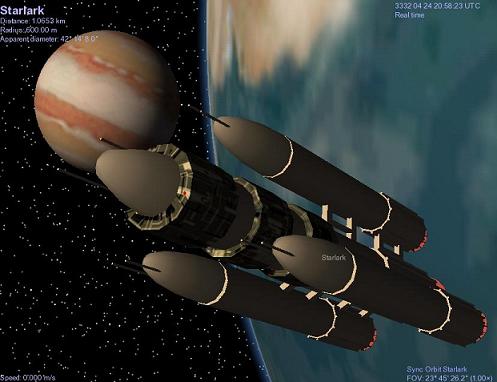BY LETTER
Starlark, The
Technology > Application > Transportation > Ships > Classic Ships
Culture and Society > Cultural Factors > Interstellar Colonization
Culture and Society > Economics > Interstellar Trade
Technology > Application > Transportation > Interstellar Transport
Sophonts > Modosophonts > Sophont Ships
Culture and Society > Cultural Factors > Interstellar Colonization
Culture and Society > Economics > Interstellar Trade
Technology > Application > Transportation > Interstellar Transport
Sophonts > Modosophonts > Sophont Ships
 Image from Steve Bowers | |
| The Starlark with its droplet radiators fully extended | |
Other members of this class included the Skylark of Valeron (launched in 642 to Barnard's Star), the Sanderling (launched to Epsilon Eridani in 650), the Nightlark (launched in 683 but lost in transit), the Great Northern (launched in 662 to Tau Ceti), the Shorelark(launched in 692 to p Eridani) and the Sandlark (launched in 703 but also lost).
The StarLark arrived at Epsilon Indi in 764 a.t., but the small colony already established there ('Tierra del Fuego') by the Prudence Foundation was in political turmoil; many of the defrosted refugees were taken for slaves, and the ship itself commandeered by the local government. Following a coup the Starlark was refuelled and set off into interstellar space once again, this time taking half the former government of del Fuego into exile, and a cargo of cloned zygotes.
Over the next two thousand years the Starlark journeyed through the Inner Sphere, as the Eridanus League, the Doran Empire, the Virginis Combine, and the First Federation developed around them; this ship became one of the first relativistic traders carrying colonists, genetic material, technology and information from star to star. After many upgrades the ship was eventually capable of one third lightspeed, and embarked on a new career as a trader within the Middle Regions. After the ship was eventually retired at Argelander in 2889 several nanotech replicas of this famous ship (with advanced monopole drive systems) were built and continued to trade in the NoCoZo and Communion of Worlds until after the Version War.
 Image from Steve Bowers | |
| The Starlark prepares to leave Anomie | |
The Starlark was 1200 metres long without shields, and built of lightweight carbon-titanium composites; its mass without fuel was 2 million tonnes, and with fuel (including external tanks) 200 million tonnes.
With four powerful antimatter-catalysed fusion motors and massive external propellant tanks during the acceleration phase, the Starlark (when first built) could reach ten percent of light speed. A superbright ship's brain known as Fred Hoyle controlled the daily operation of the ship, with a human crew as back-up working in shifts throughout the voyage.
 Image from Steve Bowers | |
| The Starlark in Deep Space. Most of the ships launched in the period immediately after the Great Expulsion were assisted in some way by the goddess GAIA; the numerous class of ships including the Starlark and the Skylark of Valeron were also considered to be GAIA arks by many observers, although the truth is more complex. | |
When leaving the Solar System for the first time, the Starlark was assisted by GAIA's boostbeam. For deceleration the ship used a magbrake as well as antimatter-catalysed fusion drive, using amat supplied by GAIA. In order to safeguard the precious and dangerous antimatter against misuse, this fuel was kept in a containment vessel with a slaved AI control system loyal only to the Goddess herself.
The Starlark and her sister ships are often counted among the arkships built and resourced directly by GAIA. However, apart from the propulsion systems, these ships were mostly constructed by the refugees themselves, using fabrication systems which met GAIA's strict guidelines. Despite this, the ships were hastily designed and overcrowded, and had barely adequate shielding. Several of these craft failed to reach their destinations, probably because they collided with interstellar debris, or perhaps due to tampering with the amat containment system.
Additionally the cryostasis hibernation technology available at that time was not entirely reliable, and a proportion of the refugees stored in the central hold did not survive, or suffered various kinds of brain damage and other ill effects. Later in the history of this long-serving vessel more advanced nanostasis technology allowed a near-total survival rate, just as upgraded drive systems decreased the average time between stars.
Related Articles
Appears in Topics
Development Notes
Text by Steve Bowers
Initially published on 13 September 2005.
Initially published on 13 September 2005.
Additional Information
Fiction about the Starlark
The voyages of the Starlark - a blog
The voyages of the Starlark - a blog







